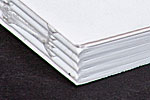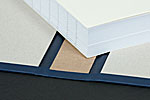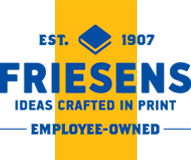Friesens offers a full line of binding equipment all in our state-of-the-art facilities.
Binding is the art of putting pages together and attaching them to a cover. There are many types of binding, and many steps are required in the binding process.
Friesens has the following state-of-the-art binding processes:

Saddle Stitch
A binding process using wire staples most often used in magazines or magazine-type work or books under 96 pages.

Perfect Binding
Also called adhesive binding. Perfect binding requires no staples or thread and uses hot or cold glue. Hot melt is more common because it is economical and dries quickly. Cold glue is an involved process, but has the advantage of allowing the book to open more easily and lie flat.

Sewn Binding
Sews signatures using threads. Signatures are sewn together, and an endsheet is put on the front and back. The book block is then attached to the cover. This is common for all hard cover and some softcover books. Commonly referred to as Smyth sewn.

Library
A stronger binding than that used for trade and educational books, including an endsheet reinforced with woven tape. Either side sewn or saddle sewn, i.e., a ‘reinforced endsheet.’

Layflat Sewn
Sews the signatures using threads, the cover is bound to the bookblock with no glue down the spine allowing the book to lay flat when opened.

Layflat Perfect Bound
The book block is perfect bound using glue, the cover is bound to the book block with no glue down the spine to allow the book to lay flat when opened.

Side Sewn
Sews through the signature instead of along the end. The book will not lie flat, but binding is extremely secure.

Quarter Binding
Limited edition books are commonly quarter bound. Quarter bound books historically used genuine leather on the spine, and a good linen material on the front and back case. Quarter binding is popular for two reasons. First, it is considerably more economical to use leather on the spine only, rather than on the entire book. Second, it is possible to achieve an attractive colour combination using two different materials in complementary colours. Genuine and simulated leather come in a variety of colours and grains and many stock combinations can achieve an attractive book.

Cerlox
Used for books which must lie flat when opened. Cookbooks and desk diaries are two common cerlox bound books. Cerlox elements are available in a variety of colours. Spines can be imprinted.

Wire-O
A more durable binding than Cerlox for lay flat books. Silver Wire-O is standard and most widely used. However, there are a variety of colours to choose from.

Plastic Spiral
A plastic coil run through the pages to allow the book to lay flat when open.
Hard Covers
Hard covers are made of two components: Cover board and cover wrap material. Board is available in 80, 100, 120 and 150 pt. weights.
Cover wrap is available in woven and non-woven materials which can be printed in a 4-colour process, foil stamped, spot UV coated, embossed and then wrapped to the board.


Square Back Case
The square back case has board equal in weight to the cover down the spine of the case.


Round Back Case
The round back case is bound with thin board in the spine allowing the spine to be slightly rounded.

Three Piece Case (Quarter Binding)
A three piece case encases your book using two different cover materials.
Soft Covers

Soft Cover
Soft cover material is generally white to maximize colour options when printing; however, many stocks are available. Cover stock material is available in 8/10/12/15 pt. weights. In most cases, a soft cover will be finished with a coating or a laminate for added durability.

Soft Cover with Flaps
Soft covers with flaps are becoming more common, providing additional real estate to help market your book. In many cases, the cover can be folded in one pass to increase the copy area without substantially increasing cost.
Friesens offers a wide range of in-house cover enhancements to make your books jump off bookstore shelves.
Lamination
The most commonly used cover coating is ½ mil mylar lamination. In addition to adding visual appeal to a jacket or cover, it adds strength. Lamination can be coated, embossed, debossed or foil stamped and is available in the following finishes.
- Gloss
- Matte
- Satin scuff resistant
- Matte scuff resistant nylon
- Coatings
Coatings are used for short life products such as catalogs, calendars and field guides or as an additional cover enhancement.
- Aqueous Coating – gloss coating applied as a flood coat.
- Spot UV – high gloss finish which is applied over matte laminate to provide a glass/matte contrasting effect on a cover.
- Flood UV – high gloss coating that offers additional protection over Aqueous, but is not as strong and durable as laminate.
Additional Cover Enhancements
- Embossing means raising the image above the paper level. This is done by heat and force. A male and female die is required for the embossing process where dies are pressed together to raise the paper.
- Debossing is the process of indenting or stamping down into the cover material. It is recommended you use a 120pt. cover board for this effect. Debossing uses a single flat die, usually made of magnesium or copper.
- Sculptured Dies are mainly used for intricate designs with many levels of embossing. These dies are produced using up to seven levels of relief on the finished project. A male and female die are produced for this process and require a great deal of pressure to achieve the different elevations.
- Foil Stamping is a popular finish, enhancing your cover or dustjacket. It involves a simple flat die which is heated, and then stamped with foil onto paper.
- think4D® is a Friesens patented technology transforming two-dimensional printing into an ultra three-dimensional art form.
- Die Cutting, like foil stamping and embossing, requires a die. This die is used to cut out a portion of the cover or jacket. Dies can be made for simple squares or circles, or more complex designs.
All hard cover books and some soft cover books have endsheets. This is paper glued to inside covers and the book block, adding strength and durability to the binding.

Endsheets – Front and back endsheets can be similar or different, plain or printed paper. Traditionally a heavy (minimum 80 lb.) book paper.

Fly Sheets – Usually translucent or coloured paper that enhances any hard or soft covered book.

Tip-ins – Can be accommodated anywhere in your book. Commonly translucent sheets or additions such as 4- or 8-page gatefold or maps.

Ribbon(s) – Provide consumers with a permanent bookmark. Add a ribbon to any book, providing a permanent book mark.
Padded Cover – Adds a comforting feel to the cover of any book.

Ragged Edge – Features an old style look, giving the appearance of hand folded pages.






 Our Divisions
Our Divisions